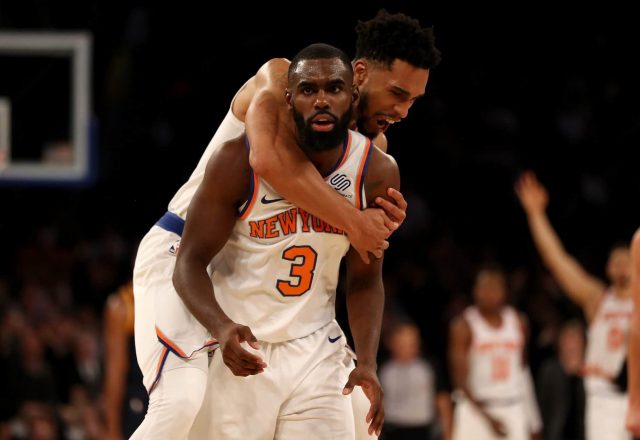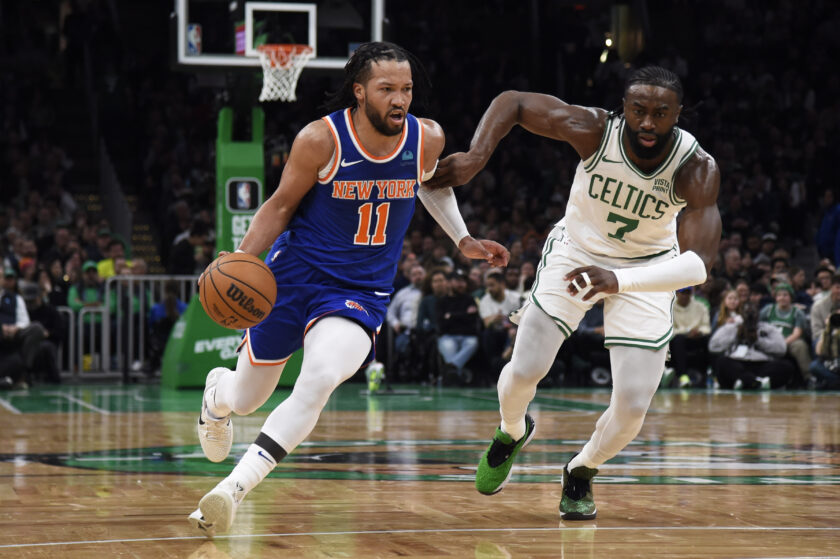New York Knicks: Tim Hardaway Jr. is finally a mature basketball player

In his fifth NBA season, Tim Hardaway Jr. has finally become more than a scorer. He is now a willing passer and rebounder.
[sc name=”Knicks Center”]When the New York Knicks agreed to send Tim Hardaway Jr. packing during the summer of 2015, the then 23-year-old had plenty to learn about how to play team ball.
Hardaway Jr., just one season removed from All-NBA Rookie First Team honors, quickly found himself on the receiving end of the New York faithful’s criticism.
He had not developed as a passer. He had not developed as a defender. He was still the same one-dimensional player from his rookie season. His failure to mature as a player—and me-first mindset—were some of the reasons the Knicks traded him to Atlanta.
It’s why many, including myself, questioned the Knicks’ $71 million Hardaway reunion this summer.
But 17 games into the 2017-18 NBA season, it is clear he is a different player.
It may have taken five NBA seasons, but Hardaway Jr. has finally matured into the player Knicks fans had hoped he would be after his rookie season.
Hardaway’s assist numbers are up to 3.1 on the season and he’s pulling down 4.4 rebounds per game, both career bests. In the last five games, he’s averaged 21.6 points, 4.8 assists and 6.4 rebounds per game.
To put things in perspective, Hardaway Jr. only reached those numbers once before this season. He’s done it three times so far in 2017-18.
He’s passing the ball at a greater rate than in year’s past. In Hardaway’s first season with the Knicks, playing 23 minutes per game, he made 17.3 passes per game. This number increased to 31.9 in his second year while playing 24 minutes.
Things only went downhill for Hardaway when he was traded to Atlanta. His passes per game slipped to 14.1 (in 17 minutes per game) and 25.4 the season after (in 27 minutes per game). This was particularly worrisome due to a Mike Budenholzer offense predicated on ball movement.
This season, he’s making 35.6 passes per game, the highest of his career, in almost 34 minutes per game.
One of the biggest beneficiaries of Hardaway Jr.’s passing has been Kristaps Porzingis. Porzingis has seen an average of seven passes per game from THJ. This is the second-most passes Porzingis has received from any teammate, outside of Jarrett Jack. Additionally, Hardaway Jr. has assisted on one Porzingis bucket per game.
Porzingis releasing off screens for Hardaway has led to many of scoring opportunities for the Latvian.
The Hardaway Jr. of the past was not poised enough to make this pass. Instead of swinging the ball around the perimeter or over-dribbling, he keeps his composure and delivers two perfect passes to KP.
The 25-year-old has also gotten Porzingis the ball in the right spots on offense.
Porzingis has been eating all season at the low block. He has the second-most points scored in the post in the NBA.
Hardaway Jr. sees the mismatch, creates some space between him and Porzingis to avoid KP getting doubled, and Porzingis knocks down the jumper.
While THJ has certainly developed a tremendous amount since his first stint with New York on the offensive end his defense is still a work in progress. But it’s better than it has been.
Hardaway Jr.’s DBPM (Defensive Box Plus/Minus), while not impressive, is the lowest of his career at -0.9. Despite his reputation as a bad defender, the Knicks’ opponent offensive rating actually goes down with Hardaway Jr. on the bench, granted not by much.
These are not great defensive numbers. Nobody is going to claim that Tim Hardaway Jr. has become an above average NBA defender, but he has certainly been better than in previous years.
It’s way too early to say Hardaway Jr.’s improved vision and rebounding has made his bloated contract a good deal. Likewise, it is too early to say Hardaway Jr.’s deal is now the greatest bargain in NBA free agency history.
But it is not too early to say that this is not the same player that was run out of New York a few seasons ago.
Hardaway Jr. is by no means a player without frustrations. His isolation rate of 8.5 percent is too high for a player of his caliber, especially one who plays with an elite talent like Porzingis. He takes far too many shots with plenty of time left on the shot clock. And of course, fans would love to see him become a better defender.
However, if he has shown anything this season, it is that Hardaway Jr., who has still yet to enter the prime years of his career, will continue to improve and expand his game.
[sc name=”Knicks Link Next” link=”https://elitesportsny.com/2017/11/24/new-york-knicks-odds-and-ends-fuelling-the-early-success/” text=”Knicks’ Odds and Ends Fueling Early Success” ]Charles is a sophomore at Pennsylvania State University from Long Island, New York, majoring in broadcast journalism.
As a member of Penn State's CommRadio, the official radio station of the College of Communications, Charles has written various articles covering Penn State football and basketball. In addition to writing, Charles also co-hosts Empire State College, the only New York sports talkshow on campus.





